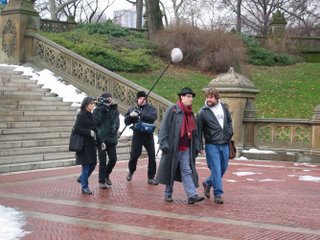
It's only fitting that my 80th post concern Halloween, which is my favorite holiday of the year--as you might have guessed given the monstrous orientation of a number of the preceding 79 missives. I passed through the costumes phase of Halloween long ago; my favorite was a spooky devil's mask that was, appropriately, hot as hell to wear, but never failed to startle candy-givers used to kids in tamer outfits. A little sadly, I've also passed out of the gifting phase; parents are loathe to hazard New York City streets with their tykes and I haven't treated a Halloweener in years, which probably means--damn!--I'm going to have to eat that bag of $100,000 Bars I bought just in case from the Pathmark myself.
[My mother would roll her eyes at this. She gets upwards of 150 trick-or-treaters in the suburbs of northern NJ, more in good weather--and tomorrow is expected to be spectacular. She fobbed the job off to me when I was in my late teens but was forced into reemployment when I flew the coop. Her favorite trick-or-treater is...me. I went back and forth to and from the nest today to pick up my goodie bag. The 41 Year-Old-Halloweener.]
One constant on Halloween is, of course, scary movies, which you never age out of. I imagine a lot of big kids will make a pilgrimage to Saw III tomorrow night, but not me; I find a lot of modern horror too depressingly nihilistic, more cynical and enervating than nerve-jangling. If I want that kind of horror, I'll turn on the appalling Nancy Grace for all the breathless details about the crime of the day.
So we're off to see Tim Burton's The Nightmare Before Christmas, reformatted for 3D, tomorrow evening. My first exposure to the film, in 1993, was dismal; I was in a time of transition that year, and in no mood for levity. I didn't think much of it till the HMV that used to be on Lexington/86th in Manhattan sold off all its laserdiscs in the late 90s; one of them was the gorgeously packaged deluxe package that Disney put out of that film, which I scooped up. What a difference the passage of time had made; I loved it, and would likely haul it out this year, if it weren't for the new theatrical print (I'm a sucker for 3D, and think everything should be in the format, especially talky art films that could use a little zip and zing) and the fact that my LD player is still in storage, awaiting a new stand, which no one seems to want to custom-build for us. Having survived Jaws, Lora--not a horror film fan--has submitted to indoctrination by Nightmare. I think she'll love it; after all, at its core, it is a musical comedy.
Speaking of musical comedy, we listened to "Science Fiction Double Feature," the first cut off The Rocky Horror Picture Show album, last night. The first of the 11 creature features mentioned in its lyrics is The Day the Earth Stood Still, which we watched last night via TCM, which really puts its best fright forward before and during Halloween. What a timeless, witty, and engrossing picture the 55-year-old Day is; so long as there's war, its brand of humanism will never go out of date, and besides the big picture themes (and that amazing Bernard Herrmann score, and Michael Rennie and Patricia Neal, and Gort the robot, everyone's favorite enforcer) it packs a lot of little things into its 92 minutes: vivid location shooting in Washington, D.C., a great, pre-Father Knows Best performance by Billy Gray, a movie kid for the ages, and lots of amusing, at times inadvertently revealing touches. When the military and scientific personnel assess the alien threat, they inevitably light up as the conversations intensify, ignorant or the first- and second-hand danger right in front of them.
If you're looking for film fare tomorrow night, you could do worse than watching the films listed in the "Science Fiction" song. The writing is very astute, though Doctor X (1932) does not build a creature (he is the creature, encased in synthetic flesh) and you'd have no idea how good Night of the Demon (1958) is from the sophomoric "casting the runes" lyrics. I don't think It Came From Outer Space is out of on DVD, and Forbidden Planet is coming next month in a spiffy 50th anniversary version. Unless you like noisy, stringed spaceships I'd cheat and watch the deliciously campy 1980 Flash Gordon over the 1935 serial. King Kong and The Invisible Man, from 1933, are readily accessed via Netflix, as are Tarantula (1955) and When Worlds Collide (1951). The DVD of 1963's Day of the Triffids could be better tended than it is.
And, yes, I have them all. It's always Halloween in my house, just a little more, tomorrow.












